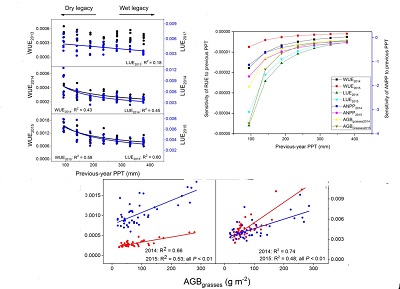On January 11, 2021, the research team published the latest research results in Functional Ecology: Asymmetric responses of resource use efficiency to previous-year precipitation in a semi-arid grassland. Functional Ecology is an international mainstream journal of ecology published by Wiley. The journal publishes about 200 articles per year, with an impact factor of 4.43 in 2020, which belongs to the top journal of SCI Region 1 of the Chinese Academy of Sciences. The first author of this research result is Dr. Han Juanjuan, a former staff member of the Global Change Ecology Laboratory (currently working at Southwest University and an external collaborator of the team), and the corresponding author is Professor Wan Shiqiang. The research was supported by the National Natural Science Foundation of China Key Project (31830012), and its experimental platform (precipitation gradient experiment) was set up in the "Thirteen Litan Base of Duolun Restoration Ecology Experimental Station, Institute of Botany, Chinese Academy of Sciences" located in Duolun County, Inner Mongolia. This paper uses some data from the precipitation gradient experiment from 2013 to 2015 to conduct a more in-depth analysis and discussion based on a previous paper published on the experiment (Multiple Resource Use Efficiency (mRUE): A New Concept for Ecosystem Production).
Climate change scenario models predict that future global warming will exacerbate rainfall variability in arid regions. In this context, the occurrence of extreme rainfall and average rainfall not only affects the current ecosystem, but also has a long-term, far-reaching and uncertain lagging impact on the subsequent ecosystem structure and function. In this study, we mainly collated the 3-year recovery period data after 3 years of rainfall treatment and found that both light and water use efficiency were more sensitive to past droughts than humidity, and more sensitive to extreme drought (60% reduction in rainfall) than average humidity (60% increase in rainfall), although the magnitude of rainfall changed by both was the same. The change of biomass of grasses is the main reason for the asymmetry of resource use efficiency to past rainfall. The publication of the results will help predict the impact of future rainfall patterns on community composition and ecosystem function.

Figure 1. Water use efficiency (WUE) and light use efficiency (LUE) responses to past rainfall (a), linear relationship with grass biomass (AGBgrasses) (b) and their sensitivity (c).

